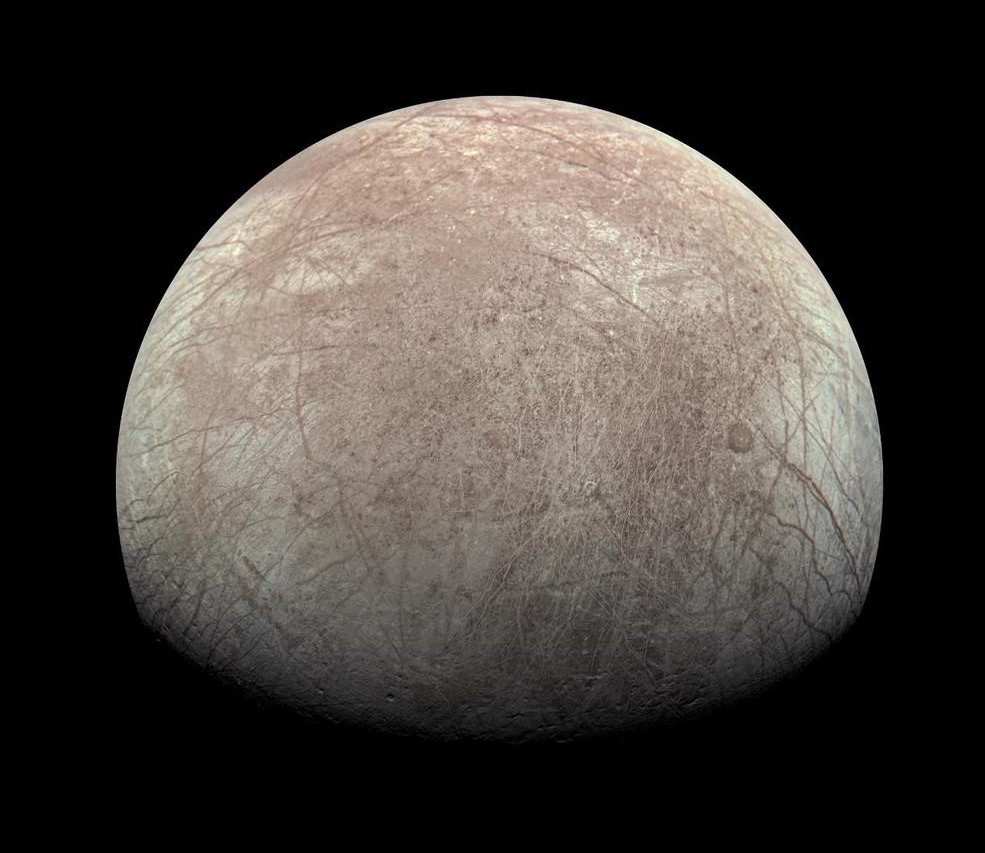Jupiter’s moon, Europa, contains a large ocean of salty water beneath its icy shell, some of which makes it to the surface from time to time, and this vast ocean could host life, as well. Europa was most recently observed by NASA’s Juno spacecraft, but current examinations of the moon’s internal ocean are limited to computer models and simulations produced here on Earth, as no mission is actively exploring this tiny moon orbiting Jupiter. Other than the internal water occasionally breaching the icy shell and making it to the surface, what other effects could the internal ocean have on the icy shell that encloses it?
This is what an international team of researchers hope to answer as they examined the rotational relationship between Europa’s icy shell and the small moon’s interior ocean. While scientists have long suspected the free-floating properties of the ice shell, meaning it’s detached from the interior ocean, this new study is the first to present new modeling that suggests the currents of the ocean could be driving the icy shell’s rotation.

For the study, the researchers examined the drag force exhibited between the icy shell and the ocean beneath it. In fluid mechanics, the drag force is what a solid object experiences as it moves through a surrounding fluid. In this case, the bottom of Europa’s icy shell that’s moving through the interior ocean. The study also offers hints that Europa’s surface features of countless cracks and ridges could also be the result of the icy shell stretching and compressing while it’s being dragged along by the interior ocean.
“Before this, it was known through laboratory experiments and modeling that heating and cooling of Europa’s ocean may drive currents,” said Dr. Hamish Hay, who is a researcher at the University of Oxford University but performed the research while a postdoctoral research associate at NASA JPL-Caltech, and is lead author of the study. “Now our results highlight a coupling between the ocean and the rotation of the icy shell that was never previously considered.”
Scientists have been arguing for decades over the rotational speeds between the icy shell and interior ocean, specifically pertaining to if the shell rotates faster. However, scientists have always tried to use Jupiter’s massive gravity tugging on Europa and its icy shell as the reason why the icy shell might rotate faster than the ocean, but they haven’t considered the ocean itself as being the reason, until now.
“To me, it was completely unexpected that what happens in the ocean’s circulation could be enough to affect the icy shell. That was a huge surprise,” said Dr. Robert Pappalardo, who is a Europa Clipper Project Scientist at JPL, and a co-author on the study. “And the idea that the cracks and ridges we see on Europa’s surface could be tied to the circulation of the ocean below – geologists don’t usually think, ‘Maybe it’s the ocean doing that.’”
In collaboration with the NASA Advanced Supercomputing Division, the researchers developed circulation models of Europa’s interior ocean using the same methods to develop models for studying the oceans of the Earth. Scientists have long hypothesized that Europa’s internal ocean is heated from the bottom from a combination of radioactive decay and tidal heating, and created simulations to determine how this could affect the ocean circulation.
The research team discovered that while the ocean circulation appeared to start off with vertical motion—north-south and south-north—from the bottom of the ocean, Europa’s rotation caused these currents to eventually veer horizontally—east-west and west-east. When the researchers incorporated the drag force into their models, they discovered that with enough speed the ocean currents could alter the rotation speed of the icy shell above over time, making it move either faster or slower. In the end, the researchers determined that as the internal ocean circulation changes over time, so does the rotation speed of the icy shell.

“The work could be important in understanding how other ocean worlds’ rotation speeds may have changed over time,” said Dr. Hay. “And now that we know about the potential coupling of interior oceans with the surfaces of these bodies, we may learn more about their geological histories as well as Europa’s.”
A vital piece to learning more about Europa and its internal ocean is NASA’s upcoming Europa Clipper mission, which is currently scheduled to launch in 2024 and arrive at Jupiter in 2030. While the primary science objective of Europa Clipper will be to determine the potential habitability of Europa, specifically pertaining to its internal ocean, this mission could also offer an enormous opportunity to learn more about how the internal ocean affects the icy shell and the rotational behavior of them both. In preparation for the missions, scientists at NASA JPL are currently using a simulation chamber called “The Ark” to learn more about Europa before Clipper gets there.
What new insights will scientists learn about Europa’s internal ocean and its effects on the moon’s icy shell in the coming years and decades? Only time will tell, and this is why we science!
As always, keep doing science & keep looking up!


“ALL THESE WORLDS ARE YOURS – EXPECT EUROPA”
Isaac Asimov
Wait a minute – you know Ray Bradbury wrote that, not Isaac. Or was Robert Heinlein?